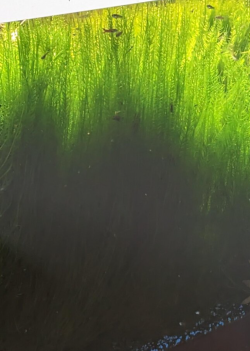I have a folder labelled Nitrate with papers. But, It has been a while since I looked to see what was new. Here is one example (click the link in the citation to see the full paper):
Daniel F Gomez Isaza, Rebecca L Cramp, Craig E Franklin, Simultaneous exposure to nitrate and low pH reduces the blood oxygen-carrying capacity and functional performance of a freshwater fish,
Conservation Physiology, Volume 8, Issue 1, 2020, coz092,
https://doi.org/10.1093/conphys/coz092
Abstract
Human activities present aquatic species with numerous of environmental challenges, including excessive nutrient pollution (nitrate) and altered pH regimes (freshwater acidification). In isolation, elevated nitrate and acidic pH can lower the blood oxygen-carrying capacity of aquatic species and cause corresponding declines in key functional performance traits such as growth and locomotor capacity. These factors may pose considerable physiological challenges to organisms but little is known about their combined effects. To characterise the energetic and physiological consequences of simultaneous exposure to nitrate and low pH, we exposed spangled perch (
Leiopotherapon unicolor) to a combination of nitrate (0, 50 or 100 mg L−1) and pH (pH 7.0 or 4.0) treatments in a factorial experimental design. Blood oxygen-carrying capacity (haemoglobin concentration, methaemoglobin concentrations and oxygen equilibrium curves), aerobic scope and functional performance traits (growth, swimming performance and post-exercise recovery) were assessed after 28 days of exposure. The oxygen-carrying capacity of fish exposed to elevated nitrate (50 and 100 mg L−1) was compromised due to reductions in haematocrit, functional haemoglobin levels and a 3-fold increase in methaemoglobin concentrations. Oxygen uptake was also impeded due to a right shift in oxygen–haemoglobin binding curves of fish exposed to nitrate and pH 4.0 simultaneously. A reduced blood oxygen-carrying capacity translated to a lowered aerobic scope, and the functional performance of fish (growth and swimming performance and increased post-exercise recovery times) was compromised by the combined effects of nitrate and low pH. These results highlight the impacts on aquatic organisms living in environments threatened by excessive nitrate and acidic pH conditions.
I have a number of papers bookmarked which deal with specific species. Here is an example but you need institutional access to read the full paper at no charge or else you have to pay to read it.
Learmonth, C. and Carvalho, A.P., 2015. Acute and chronic toxicity of nitrate to early life stages of zebrafish—setting nitrate safety levels for zebrafish rearing.
Zebrafish,
12(4), pp.305-311.
Abstract
Recirculating aquaculture systems (RAS) have been widely used for zebrafish rearing, allowing holding of many thousands of fish at high densities. Water quality in RAS largely depends on biofilters that ultimately convert the extremely toxic ammonia excreted by fish into the much less toxic nitrate. However, when water renewal is minimal in RAS, nitrate can accumulate to high enough levels to negatively impact fish welfare and performance. Therefore, the setting of safety levels of nitrate for zebrafish should be a priority to avoid unwanted effects in both the intensive production of this species and research outputs. The present study aimed to define nitrate safety levels for zebrafish based on acute and chronic toxicity bioassays in early life stages of this species. Acute bioassays revealed ontogenetic changes in response to high nitrate levels. Based on NOEC (no observed effect concentration) values, safety levels should be set at 1450, 1855, and 1075 mg/L NO3−-N to prevent acute lethal effects in embryos, newly-hatched larvae, and swim-up larvae, respectively. In the chronic bioassay, larvae were exposed to nitrate concentrations of 50, 100, 200, and 400 mg/L NO3−-N during the entire larval period (23 days). No negative effects were observed either on larval performance or condition at concentrations up to 200 mg/L NO3−-N. However, at 400 mg/L NO3−-N, survival drastically decreased and fish showed reduced growth and evidence of morphological abnormalities. Accordingly, a safety level of 200 mg/L NO3−-N is recommended during the larval rearing of zebrafish to prevent negative impacts on juvenile production.
As you can see from the above the nitrate levels are insane. They are expressed on the nitrogen scale which means you have to multiply them: NO3 = NO3-N * 4.42664
Based on "Accordingly, a safety level of 200 mg/L NO3−-N is recommended during the larval rearing of zebrafish to prevent negative impacts on juvenile production." the reading on an API kit would be 885 ppm. Of course the API test has a top reading of 160 ppm so you would have to do diluted testing. Instead of using their 5 ml level vial you would need to use over 6 times that amount of tank water, i.e. 30 ml.
So there is research out there. You can click this link to Google Scholar and find a ton of papers.
https://scholar.google.com/scholar?...oxicity+of+Nitrate+to+freshwater+fishes&btnG=
You will see "About 33,200 results" so you may want to limit that to more recent papers by clicking on Custom range and entering beginning and ending years.


